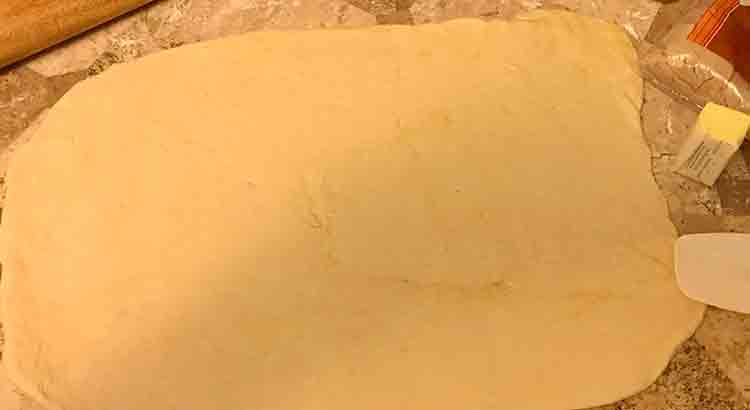Are you tired of making cinnamon rolls with dry, crumbly dough? There’s nothing more disappointing than biting into a dry cinnamon roll that lacks that tender, moist texture that we all crave. The good news is that making perfect cinnamon roll dough is easier than you might think.
The most common reason why cinnamon rolls dough gets too dry is overkneading the dough. Overkneading the dough also over kneads the gluten. When the gluten strands are overworked, they become tough and tight, and the dough becomes dry and difficult to work with.
In this article, we’ll explore seven common mistakes that can result in dry cinnamon roll dough. From overkneading the dough to using too much flour, we’ll break down the reasons why your cinnamon roll dough might be too dry, and offer simple solutions to help you make the perfect dough every time.
1. Overkneading
Kneading is an essential step when making cinnamon roll dough. It helps develop the gluten in the flour, making the dough elastic and able to rise. However, overkneading the dough can lead to a dry and tough texture. When you overwork the dough, the gluten strands become too tight, resulting in a dry and crumbly texture.
To prevent this from happening, only knead the dough until it is smooth and elastic. You can tell when the dough is ready by performing the “windowpane test.” To do this, take a small piece of dough and stretch it between your fingers. If the dough is thin enough to see light through it without tearing, then it’s ready. Don’t continue kneading beyond this point, or you risk overworking the dough and making it too dry.
2. Using Low-Fat Milk
Cinnamon roll dough requires a liquid ingredient to bind the dry ingredients together. While you can use water or any type of milk, using low-fat milk can result in a dry dough. This is because the fat in the milk helps keep the dough moist and tender.
To ensure that your cinnamon roll dough is not too dry, use whole milk or buttermilk instead of low-fat milk. If you are looking for a healthier alternative, you can use almond milk, soy milk, or oat milk. Just keep in mind that the texture of the dough may be slightly different depending on the type of milk you use.
3. Too Much Sugar
While sugar is necessary to feed the yeast and create a tender texture in cinnamon roll dough, too much sugar can result in a dry dough. This is because sugar absorbs moisture from the dough, leaving it too dry and crumbly.
To prevent this, make sure you are measuring your sugar accurately and not adding more than the recipe calls for. You can also try adding a bit more liquid to the dough to compensate for the extra sugar.
4. Too Much Salt
Just like sugar, salt is necessary to balance the flavors and help the yeast work properly in cinnamon roll dough. However, adding too much salt can result in a dry dough. This is because salt can absorb moisture from the dough, leaving it too dry and tough.
To prevent this, make sure you are measuring your salt accurately and not adding more than the recipe calls for. You can also try adding a bit more liquid to the dough to compensate for the extra salt.
5. Not Using Enough Eggs
Eggs are a crucial ingredient in cinnamon roll dough. They provide moisture and help create a tender texture. If you don’t use enough eggs, the dough can be too dry and tough.
To prevent this, make sure you are using the correct amount of eggs called for in the recipe. If you want to experiment with reducing the number of eggs, make sure to add an equal amount of liquid to the dough to compensate for the lost moisture. However, keep in mind that this can change the texture of the dough.
6. Not Letting the Dough Rest
After kneading the dough, it’s essential to let it rest before rolling it out and shaping it. This allows the gluten strands to relax, making the dough easier to work with and resulting in a tender texture. If you skip this step and try to shape the dough immediately, it can result in a dry and tough texture.
To prevent this, make sure you let the dough rest for at least 10-15 minutes after kneading. Cover the dough with a damp cloth or plastic wrap to prevent it from drying out.
7. Too Much Flour
Adding too much flour to cinnamon roll dough can result in a dry and crumbly texture. This is because too much flour can absorb too much moisture from the dough.
To prevent this, make sure you measure your flour accurately and do not add more than the recipe calls for. You can also try using a kitchen scale to measure your flour by weight instead of volume, as this can be more accurate. If you accidentally add too much flour, try adding a bit more liquid to the dough to compensate for the extra flour. However, keep in mind that this can change the texture of the dough.
Final Thoughts
Making perfect cinnamon roll dough can be a challenge, but by avoiding these common mistakes, you can ensure that your dough turns out moist, tender, and delicious.
Remember to knead the dough only until it’s smooth and elastic, and avoid using low-fat milk. Use the correct amount of sugar and salt, and make sure to use enough eggs. Let the dough rest before rolling it out, and measure your flour accurately to avoid using too much.
By following these tips, you can make cinnamon roll dough that is just right. Don’t be afraid to experiment and find the perfect recipe that works for you. With a little practice and patience, you can enjoy delicious homemade cinnamon rolls any time you want!

